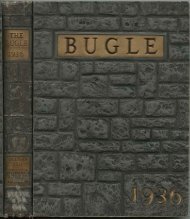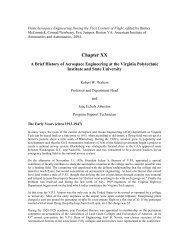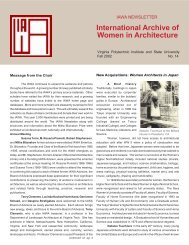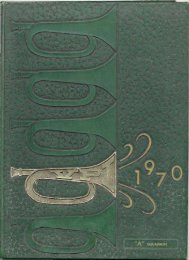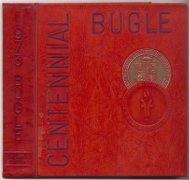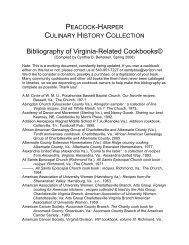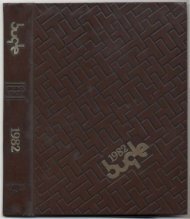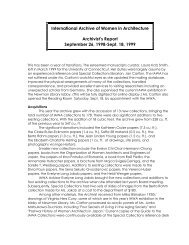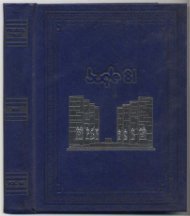International Archive of Women in Architecture - Special Collections
International Archive of Women in Architecture - Special Collections
International Archive of Women in Architecture - Special Collections
You also want an ePaper? Increase the reach of your titles
YUMPU automatically turns print PDFs into web optimized ePapers that Google loves.
IAWA NEWSLETTER<br />
<strong>International</strong> <strong>Archive</strong> <strong>of</strong><br />
<strong>Women</strong> <strong>in</strong> <strong>Architecture</strong><br />
Virg<strong>in</strong>ia Polytechnic Institute and State University<br />
Fall 2006 No. 18<br />
Korman House and Garden, photo by An-chi Tai<br />
Harriet Pattison, ASLA<br />
Kay F. Edge<br />
The IAWA is fortunate to have received some <strong>in</strong>formation<br />
about landscape architect Harriet Pattison’s work. Pattison<br />
worked with Louis Kahn on a number <strong>of</strong> projects <strong>in</strong>clud<strong>in</strong>g<br />
the Kimbell Museum <strong>in</strong> Fort Worth, Texas and the Korman<br />
residence <strong>in</strong> Whitemarsh, Pennsylvania. She is the mother<br />
<strong>of</strong> Nathan Kahn who produced the documentary film My<br />
Architect about Kahn’s life and work. What follows is a<br />
description, <strong>in</strong> Pattison’s own words, <strong>of</strong> how she sees her<br />
pr<strong>of</strong>ession.<br />
One autumn morn<strong>in</strong>g, some years ago, I was cross<strong>in</strong>g<br />
Lake Dal to visit ru<strong>in</strong>s <strong>of</strong> the Mughal Dynasty that ascend<br />
the magic mounta<strong>in</strong>s <strong>of</strong> Kashmir. When the strokes <strong>of</strong> the<br />
oarsmen drew us with<strong>in</strong> sight <strong>of</strong> the terraces and water<br />
cascades that emerge so naturally from the stony palisades,<br />
my heart soared. For here, a powerful ruler had chosen to<br />
build, not fortifications, but gardens.<br />
Formed <strong>of</strong> nature, time and the imag<strong>in</strong>ation, such gardens<br />
belong to the liv<strong>in</strong>g art that is landscape architecture. This<br />
humane art can do much for us today, from revitaliz<strong>in</strong>g our<br />
cities and plann<strong>in</strong>g the wise use <strong>of</strong> land, to design<strong>in</strong>g the<br />
susta<strong>in</strong>able environments we need to survive. And, as<br />
1<br />
it has done for cultures <strong>of</strong> the past, landscape architecture<br />
can create places where we, and future generations, will<br />
come to feel at home on the earth.<br />
As a modern landscape architect, I am <strong>in</strong>spired by these<br />
goals and by the landowners, corporate groups and architects<br />
whose needs I serve. When I see how Nature welcomes<br />
the gardens and landscapes I have begun, and how they<br />
enhance people’s lives, I rejoice <strong>in</strong> follow<strong>in</strong>g a dist<strong>in</strong>guished<br />
tradition <strong>of</strong> artists who unite human and natural forces <strong>in</strong><br />
harmony.<br />
In January <strong>of</strong> 2004, Pattison presented at the symposium,<br />
Engag<strong>in</strong>g Louis I. Kahn: A Legacy for the Future, held at<br />
the Yale Center for British Art. What follows is a description<br />
<strong>of</strong> some <strong>of</strong> her collaborations with Kahn and some <strong>of</strong> her<br />
personal memories <strong>of</strong> him.<br />
I had the privilege to work on several Kahn projects, mostly<br />
unbuilt. Though my tra<strong>in</strong><strong>in</strong>g was <strong>in</strong>complete <strong>in</strong> 1967, Lou<br />
<strong>in</strong>vited me to participate much before, because I <strong>in</strong>tuitively<br />
understood his ideas, had a background <strong>in</strong> the arts and was<br />
young, bold and ignorant enough to crit his work. Eventually<br />
I was sufficiently skilled to be effective, though like anyone<br />
who came with<strong>in</strong> his sphere, I was a m<strong>in</strong>or player.<br />
It was my good fortune to design the landscape for the<br />
Kimbell Museum, although my employer was <strong>of</strong>ficially<br />
credited with the work. I was more assertive than gentle<br />
George Patton whose f<strong>in</strong>e landscapes redeem many sites<br />
<strong>in</strong> and round Philadelphia. I soon took exception to Lou’s<br />
impos<strong>in</strong>g pl<strong>in</strong>th and eased his build<strong>in</strong>g <strong>in</strong>to its site while<br />
persuad<strong>in</strong>g him to <strong>in</strong>corporate the paired porches at the<br />
garden entrance. He said, “You know what’s so wonderful<br />
about these porches? They’re so unnecessary.” In my<br />
m<strong>in</strong>d, they were Kahn ambulatories: an alternative way to<br />
experience his build<strong>in</strong>g, the ambiguous middle ground that<br />
tied the museum to nature and lent the same dignity to live<br />
forms, that sculpture had with<strong>in</strong>. I chose groves <strong>of</strong> trees<br />
and water—reflect<strong>in</strong>g, tumbl<strong>in</strong>g, purl<strong>in</strong>g—to temper the<br />
climate, animate a featureless site, and attract the public.<br />
While design<strong>in</strong>g the south court for outdoor performances,<br />
I had to surrender the north oneto the trucks, render<strong>in</strong>g the<br />
build<strong>in</strong>g vulnerable to future, expansionist plans with
this underutilized space. Questions did arise: “Why are there<br />
only six vaults? Why not extend them <strong>in</strong>def<strong>in</strong>itely here?”<br />
Like Brancusi’s ‘Endless Column,’ the po<strong>in</strong>t at which you<br />
stop repeat<strong>in</strong>g the unit is what separates a work <strong>of</strong> art from<br />
a piece <strong>of</strong> eng<strong>in</strong>eer<strong>in</strong>g. On the other hand, Lou’s repetitive<br />
use <strong>of</strong> the hundred-foot l<strong>in</strong>ear units gave necessary walland<br />
flow-space <strong>in</strong> natural light that every museum wants<br />
but few have.<br />
The Usefulness <strong>of</strong> the IAWA<br />
Lois D. Gottlieb<br />
The <strong>International</strong> <strong>Archive</strong> <strong>of</strong> <strong>Women</strong> <strong>in</strong> <strong>Architecture</strong> (IAWA)<br />
has many uses. S<strong>in</strong>ce it resides <strong>in</strong> <strong>Special</strong> <strong>Collections</strong> <strong>of</strong><br />
Newman Library at Virg<strong>in</strong>ia Tech, it is certa<strong>in</strong>ly a useful tool<br />
for the students there, the faculty, and visitors from around<br />
the world. It is primarily a collection <strong>of</strong> draw<strong>in</strong>gs by women<br />
architects and designers, but the archive also conta<strong>in</strong>s<br />
scholarly research, writ<strong>in</strong>g and personal histories <strong>of</strong> the<br />
contributors. I myself have donated not only my draw<strong>in</strong>gs<br />
but academic work from my days at Harvard as well. I have<br />
also given a large set <strong>of</strong> photographs that I took when I was<br />
an apprentice to Frank Lloyd Wright at both Talies<strong>in</strong> and<br />
Talies<strong>in</strong> West, and a book based on these pictures.<br />
Gottlieb House:The house used pre-fabricated, recycled and<br />
ecologically sound materials and was a collaboration between<br />
Lois Gottlieb and her son on his house. Above, a pool terrace is<br />
supported by a reta<strong>in</strong><strong>in</strong>g wall <strong>of</strong> 16-foot pre-fabricated sections used<br />
to support highways <strong>in</strong> Switzerland. Below, a skylight at the ridge<br />
<strong>of</strong> the ro<strong>of</strong>; glulam beams support the entire structure.<br />
At one time I taught <strong>in</strong> an adult education program which was<br />
a course not for architects, but rather for clients <strong>of</strong> architects.<br />
I have learned that there is little hope <strong>of</strong> produc<strong>in</strong>g great<br />
architecture if one does not have a client who has some<br />
understand<strong>in</strong>g <strong>of</strong> what architecture is about. The MacMillan<br />
Publish<strong>in</strong>g Co. hired me to write a text for this course and<br />
the manuscript for this book, as well as a copy <strong>of</strong> the book<br />
are <strong>in</strong> the <strong>Archive</strong>.<br />
I was very fortunate to be an undergraduate at Stanford<br />
University where one <strong>of</strong> the pr<strong>of</strong>essors had a house designed<br />
by Mr. Wright. This house was never mentioned <strong>in</strong> any <strong>of</strong><br />
my classes, and I was about to graduate before I saw it. I<br />
still did not know what I was go<strong>in</strong>g to do after graduation,<br />
but one look at the “Hanna House” conv<strong>in</strong>ced me that I must<br />
be an architect and make someth<strong>in</strong>g similar. If one cannot<br />
actually see a house like this, surely the next best th<strong>in</strong>g is<br />
to see the work <strong>of</strong> some <strong>of</strong> the best architects from all over<br />
the world <strong>in</strong> the <strong>Archive</strong>. The collections <strong>in</strong>clude works from<br />
such far-<strong>of</strong>f places as Mongolia, India, and Japan.<br />
Another way students can benefit from the <strong>Archive</strong> is to learn<br />
about other architects – women architects <strong>in</strong> particular. I just<br />
read <strong>in</strong> the IAWA Newsletter about the students meet<strong>in</strong>g with<br />
the Italian architect Gae Aulenti. I was particularly <strong>in</strong>terested<br />
<strong>in</strong> this event because I played some part <strong>in</strong> it. Gae Aulenti<br />
had recently re-designed the Asian Art Museum <strong>in</strong> San<br />
Francisco. I live about three blocks from it and assumed<br />
there would be many <strong>of</strong> her draw<strong>in</strong>gs left beh<strong>in</strong>d. I called<br />
the museum’s adm<strong>in</strong>istration and could f<strong>in</strong>d no one <strong>in</strong>terested<br />
<strong>in</strong> my request to obta<strong>in</strong> these draw<strong>in</strong>gs. Thereafter, I patiently<br />
waited till they wrote to me ask<strong>in</strong>g for a donation for the<br />
museum. I called them and proposed that I would send<br />
them a donation if they would give me a set <strong>of</strong> the draw<strong>in</strong>gs.<br />
It took months, but I f<strong>in</strong>ally succeeded. I mention this event<br />
because it is not easy to obta<strong>in</strong> draw<strong>in</strong>gs. Architects are<br />
particularly attached to their work and one must th<strong>in</strong>k <strong>of</strong><br />
various ways to get them.) Once these draw<strong>in</strong>gs arrived at<br />
Virg<strong>in</strong>ia Tech, Pr<strong>of</strong>essor Mitzi Vernon and the students saw<br />
them and found Ms. Aulenti’s phone number and address. A<br />
group <strong>of</strong> the students plann<strong>in</strong>g a trip to Europe for a summer<br />
session, arranged a visit to her studio <strong>in</strong> Milan and meet<strong>in</strong>g<br />
with her. I’m sure that it was an <strong>in</strong>spir<strong>in</strong>g, unforgettable<br />
experience.<br />
It is important to note that the general public has access to<br />
the <strong>Archive</strong>. Many people use the material to do research on<br />
architecture and related subjects. My personal and unusual<br />
experience <strong>in</strong> this regard happened a number <strong>of</strong> years<br />
2
ago. A man called me and asked me to design a house.<br />
When I f<strong>in</strong>ally met him at my son’s house <strong>in</strong> Northern Virg<strong>in</strong>ia,<br />
I asked where he had heard <strong>of</strong> me. He described his visit<br />
to Virg<strong>in</strong>ia Tech and his <strong>in</strong>terest <strong>in</strong> the IAWA. After look<strong>in</strong>g<br />
at many designs and draw<strong>in</strong>gs collections, he decided<br />
that my work is best suited for his needs. He <strong>in</strong>tended to<br />
complete his studies <strong>in</strong> law and then build a house designed<br />
by me. It never occurred to me that the archives could be<br />
used by potential clients. These are a few <strong>of</strong> the uses <strong>of</strong><br />
the IAWA.<br />
Hous<strong>in</strong>g for Work<strong>in</strong>g <strong>Women</strong>: an Exhibition by<br />
Japanese <strong>Women</strong> Architects <strong>in</strong> Tokyo<br />
Yumiko Higashi and Milka Bliznakov<br />
The Center for the Advancement <strong>of</strong> Work<strong>in</strong>g <strong>Women</strong> <strong>in</strong> Japan<br />
sponsored an exhibition <strong>of</strong> projects on the theme “Hous<strong>in</strong>g<br />
for Work<strong>in</strong>g <strong>Women</strong>” designed by women architects to<br />
celebrate the 30 th anniversary <strong>of</strong> the Association <strong>of</strong> <strong>Women</strong><br />
Architects and Eng<strong>in</strong>eers (WAEA). The exhibition <strong>of</strong> 29<br />
projects and 13 models was exhibited <strong>in</strong> Tokyo (13 January<br />
to 12 February 2006) and <strong>in</strong>cluded discussions (January 27-<br />
28) by the authors about their work. The architect Yumiko<br />
Higashi, a found<strong>in</strong>g member <strong>of</strong> WAEA <strong>in</strong> 1976, donated to<br />
the IAWA a catalogue <strong>of</strong> the exhibition and copies <strong>of</strong> the<br />
exhibition materials.<strong>Women</strong>’s right to higher education <strong>in</strong><br />
Japan, <strong>in</strong>clud<strong>in</strong>g architecture, evolved after the end <strong>of</strong> the<br />
Second World War. Nabuko Nakahara was the first woman<br />
graduate <strong>in</strong> architecture <strong>in</strong> 1952. She is a former member<br />
<strong>of</strong> the Board <strong>of</strong> Advisors <strong>of</strong> the IAWA (see newsletter #14,<br />
Fall 2002). Nabuko Nakahara organized the first group<br />
<strong>of</strong> women architects <strong>in</strong> Japan (1953) under the name<br />
PODOKO, mean<strong>in</strong>g “Th<strong>in</strong>k<strong>in</strong>g, Debat<strong>in</strong>g, Creat<strong>in</strong>g”. She<br />
also established the first women’s architectural firm (1958)<br />
and was the found<strong>in</strong>g member <strong>of</strong> the Japanese branch <strong>of</strong><br />
the <strong>International</strong> Union <strong>of</strong> <strong>Women</strong> Archtiects (UIFA) <strong>in</strong><br />
1993. The number <strong>of</strong> women architects <strong>in</strong> Japan is grow<strong>in</strong>g<br />
cont<strong>in</strong>uously, from about 30 <strong>in</strong> the 1950’s to over 5000 to<br />
date, though not all are pr<strong>of</strong>essionally active. This exhibition<br />
had the goal to advance the social welfare <strong>of</strong> women by<br />
demonstrat<strong>in</strong>g how women themselves could reorganize<br />
their own home and make it more comfortable and easy to<br />
ma<strong>in</strong>ta<strong>in</strong>. The exhibits were organized <strong>in</strong> eight groups. The<br />
first, “Houses for families rais<strong>in</strong>g children” <strong>in</strong>cluded a house by<br />
Noriko Katsumi on a triangular lot (built <strong>in</strong> 1987). The author<br />
demonstrated how “climate, shape <strong>of</strong> land, and lifestyle<br />
def<strong>in</strong>ed a house…full <strong>of</strong> light”. The split level two-story<br />
plan helps a “busy work<strong>in</strong>g mother to raise her daughters”.<br />
Another example <strong>in</strong> this group is the remodel<strong>in</strong>g <strong>of</strong> a flat by<br />
Masako Yakabe. Slid<strong>in</strong>g doors and remodeled kitchen and<br />
bathroom provide for flow<strong>in</strong>g and well lit space.<br />
Yumiko Hagashi exhibited an “extremely small house” <strong>in</strong><br />
Tokyo (built 1998) <strong>in</strong> the group “small house and <strong>of</strong>fice<br />
(SOHO)”. Built next to the grandparents house, this two-story<br />
wood structure accommodated a work<strong>in</strong>g couple and their<br />
daughter. The ground floor conta<strong>in</strong>s the d<strong>in</strong><strong>in</strong>g – kitchen area<br />
with a space under the stairs for the wife, a fashion designer,<br />
to work. The two bedrooms are on the second floor and the<br />
workspace for the husband, a composer, is <strong>in</strong> the l<strong>of</strong>t. White<br />
walls and glass doors fill the rooms with light and augment<br />
the feel<strong>in</strong>g <strong>of</strong> spaciousness. Yumiko Higashi exhibited<br />
also a house <strong>in</strong> Tokyo (built 1997) with the group “houses<br />
for several generations”. The ground floor is occupied by<br />
a family and their daughter. The wife, a pa<strong>in</strong>ter, has her<br />
glass enclosed studio used for art classes and parties with<br />
friends hence the name <strong>of</strong> the house is “teach<strong>in</strong>g pa<strong>in</strong>t<strong>in</strong>g at<br />
home”. The grandparents live <strong>in</strong>dependently on the second<br />
floor, thus keep<strong>in</strong>g a family tradition <strong>of</strong> good relationships<br />
with children and grandchildren. Another house for liv<strong>in</strong>g<br />
with elderly family members is displayed by Hisako Suzuki.<br />
The house is actually for the families <strong>of</strong> two sisters<br />
Hisako Suzuki, Two Generation House, section draw<strong>in</strong>g<br />
3
group “houses with shops” a remodeled furniture shop which<br />
also accommodates liv<strong>in</strong>g quarters. The group “houses for<br />
s<strong>in</strong>gle mothers” is represented by Masako Yakabe with a<br />
house with mother’s quarters where “tak<strong>in</strong>g care <strong>of</strong> mother<br />
is very easy”.<br />
The discussion sessions revolved around several topics:<br />
how women architects manage to work and have children;<br />
postpon<strong>in</strong>g hav<strong>in</strong>g children while work<strong>in</strong>g for other architects<br />
until a woman becomes an <strong>in</strong>dependent practitioner;<br />
hav<strong>in</strong>g one’s <strong>of</strong>fice at home; form<strong>in</strong>g support groups with<br />
similar <strong>in</strong>terests is helpful; and above all, reorganiz<strong>in</strong>g the<br />
environment <strong>of</strong> the house to make the work <strong>of</strong> women<br />
easier.<br />
Hisako Suzuki, Two Generation House<br />
and their mother. The long but narrow lot def<strong>in</strong>es the shape<br />
<strong>of</strong> the house. The mother has a separate entrance with<br />
traditional tatami bedroom and bath on the ground floor, with<br />
kitchen, d<strong>in</strong><strong>in</strong>g and liv<strong>in</strong>g areas on the second floor. The<br />
daughters have the larger half <strong>of</strong> the house which <strong>in</strong>cludes<br />
a garage and an attic. Wood floors and ceil<strong>in</strong>gs contrast<br />
with white walls and slid<strong>in</strong>g partitions. Skylights provide<br />
additional light to the upper floor. The house is modular<br />
– based on the tatami size.<br />
Hisako Suzuki designed another modular house for a “hard<br />
work<strong>in</strong>g couple”. The two-story cube – like the house is built<br />
“to last for very long” with traditional Japanese materials<br />
and methods <strong>in</strong>clud<strong>in</strong>g extensive use <strong>of</strong> cedar wood. The<br />
ground floor conta<strong>in</strong>s an ample bathroom and a tatami room<br />
(bedroom) to be used eventually for house guests. On the<br />
second floor are kitchen, d<strong>in</strong><strong>in</strong>g, liv<strong>in</strong>g, study and bedroom<br />
areas, all divided by slid<strong>in</strong>g partitions to allow for maximum<br />
flexibility. The beautiful ro<strong>of</strong> structure is exposed to <strong>in</strong>crease<br />
the feel<strong>in</strong>g <strong>of</strong> openness and transparency.<br />
In the group “houses for many generations” Hisako Suzuki<br />
displayed a house to “assure <strong>in</strong>dependent life for the elderly”<br />
by design<strong>in</strong>g two build<strong>in</strong>gs surround<strong>in</strong>g a courtyard – a<br />
beautiful Japanese garden. The grandparents reside <strong>in</strong> a<br />
one-story structure above the garage, while the younger<br />
family has a large two-story house. Masako Hazawa also<br />
has a “house for many generations” built on a small lot.<br />
The elderly occupy the ground floor and the younger family<br />
resides on the upper two floors. Another project by Masako<br />
Hazawa is <strong>in</strong> the group “<strong>in</strong>terior redesign <strong>of</strong> condom<strong>in</strong>iums”.<br />
The small apartment has all built <strong>in</strong> furniture with shelves<br />
and cab<strong>in</strong>ets go<strong>in</strong>g up to the ceil<strong>in</strong>g. In the same group <strong>of</strong><br />
condom<strong>in</strong>ium reorganization, Noriko Katsumi has a project<br />
with beautiful built-<strong>in</strong> furnish<strong>in</strong>gs. She also exhibits <strong>in</strong> the<br />
The exhibition and discussions were very successful, as the<br />
1,400 visitors and many newspaper reporters testify.<br />
Honor<strong>in</strong>g the Contributions <strong>of</strong> <strong>Women</strong> <strong>in</strong><br />
<strong>Architecture</strong>: F<strong>in</strong>d<strong>in</strong>gs from the IAWA Milka Bliznakov Prize<br />
Beg<strong>in</strong>n<strong>in</strong>g <strong>in</strong> 1999, the <strong>International</strong> <strong>Archive</strong> <strong>of</strong> <strong>Women</strong> <strong>in</strong><br />
<strong>Architecture</strong> (IAWA) sought to further honor the contributions<br />
<strong>of</strong> women <strong>in</strong> architecture through the establishment <strong>of</strong> an<br />
<strong>in</strong>ternational prize for research, named <strong>in</strong> recognition <strong>of</strong><br />
IAWA founder Milka Bliznakov.<br />
This award, now <strong>in</strong> its sixth year, recognizes important<br />
scholarly work relative to the IAWA. Projects <strong>in</strong>clude<br />
exhibition boards, digital and photographic presentations,<br />
illustrated essays, and manuscripts. All award w<strong>in</strong>n<strong>in</strong>g<br />
projects, second stage f<strong>in</strong>alist projects, and project<br />
proposals become a part <strong>of</strong> the permanent record <strong>of</strong> the<br />
<strong>Archive</strong>. Without the research advanced by the Milka<br />
Bliznakov Prize this work would rema<strong>in</strong> largely unknown.<br />
The follow<strong>in</strong>g five selected projects from the Prize speak<br />
<strong>of</strong> women <strong>in</strong> architecture and contribute to a fasc<strong>in</strong>at<strong>in</strong>g<br />
new history.<br />
Claire Bonney <strong>of</strong> Basel, Switzerland, was the first<br />
to receive the Prize with her research on Adrienne<br />
Gorska <strong>in</strong> “The Work and Life <strong>of</strong> Adrienne Gorska<br />
(1899-1969).” Bonney f<strong>in</strong>ds Gorska had important<br />
l<strong>in</strong>ks to modern architecture, “In his biography <strong>of</strong> Eileen<br />
Gray, Peter Adam notes that it was Gorska who taught<br />
Gray to draw architectural plans around 1924 (Peter<br />
Adams, Eileen Gray Architect/Designer, New York: Abrams,<br />
1987). For Bonney “this fact alone made Gorska worth<br />
resuscitat<strong>in</strong>g.” Bonney cont<strong>in</strong>ues, “Gorska was apparently<br />
empathetic and patient enough to help Eileen Gray along.”<br />
In the case <strong>of</strong> Adrienne Gorksa’s work, we know that her<br />
niece’s basement <strong>in</strong> Houston, Texas may conta<strong>in</strong> a wealth <strong>of</strong><br />
<strong>in</strong>formation—records unavailable <strong>in</strong> libraries. There is an<br />
4
urgency to preserve work that seems to be disappear<strong>in</strong>g<br />
rapidly.<br />
Bonney corresponded with Gorska’s niece’s daughter <strong>in</strong><br />
Texas who still today may hold orig<strong>in</strong>alworks, and she<br />
spent a week <strong>in</strong> Paris to f<strong>in</strong>d out what exists <strong>of</strong> Gorska’s<br />
early build<strong>in</strong>gs. Bonney’s research uncovered references<br />
to Gorska’s work; one notable statement is from an article<br />
written <strong>in</strong> 1930 by Howard Robertson and Frank Yerbury<br />
from London’s The Architect and Build<strong>in</strong>g News. They write,<br />
“…men are not alone <strong>in</strong> feel<strong>in</strong>g this modern urge for breadth<br />
and space. One might suggest that modernism was ruthless,<br />
even brutal, and that these attributes are mascul<strong>in</strong>e. But we<br />
have evidence <strong>in</strong> a series <strong>of</strong> strik<strong>in</strong>g <strong>in</strong>teriors that women are<br />
equally respond<strong>in</strong>g to the urge for modern expression. We<br />
can glimpse, too, <strong>in</strong> these rooms designed and decorated<br />
by women artists, the great possibilities which the modern<br />
movement opens up for a field <strong>of</strong> women’s activity.”<br />
Bonney writes, “Gorska chose to study at the Ecole <strong>Special</strong>e<br />
d’<strong>Architecture</strong>. She graduated <strong>in</strong>1924 under Mallet-Stevens<br />
and thus was one <strong>of</strong> the few architects <strong>of</strong> her era to hold an<br />
architectural diploma. Bonney concludes with a personal<br />
account <strong>of</strong> her footwork to f<strong>in</strong>d the house Gorska and<br />
Madame Lipska rafashioned <strong>in</strong> 1930 from an old farmhouse<br />
barn for the wealthy American, Barbara Harris culm<strong>in</strong>at<strong>in</strong>g<br />
<strong>in</strong> meet<strong>in</strong>g the present-day owners <strong>of</strong> the Harrison House<br />
<strong>in</strong> Rambouillet, France.<br />
The second prize was awarded to Elizabeth Birm<strong>in</strong>gham<br />
from North Dakota State University for her manuscript on<br />
Marion Mahony, “Search<strong>in</strong>g for Marion Mahony: Gender,<br />
Erasure, & the Discourse <strong>of</strong> Architectural Studies.”<br />
Birm<strong>in</strong>gham’s extensive research shows how a woman’s<br />
work <strong>in</strong> architecture becomes unknown.<br />
Many know <strong>of</strong> Mahony as a Frank Lloyd Wright disciple<br />
and lesser-known collaborator on the design for the Capital<br />
<strong>of</strong> Australia, Canberra, with husband Walter Burley Griff<strong>in</strong>.<br />
Birm<strong>in</strong>gham’s research br<strong>in</strong>gs a different set <strong>of</strong> questions to<br />
challenge Mahony scholarship. She writes, “ For the past<br />
ten years I’ve been undertak<strong>in</strong>g research on Marion Mahony<br />
Griff<strong>in</strong> (1871-1961) an American architect who worked<br />
<strong>in</strong> Australia and India as well as the US. This research<br />
exam<strong>in</strong>es not just Mahony Griff<strong>in</strong>’s work but explores the<br />
methods and discourse <strong>of</strong> architectural history that have<br />
erased many women’s contributions to architecture and<br />
design.” The first chapter title clearly sets the direction<br />
<strong>of</strong> the manuscript with “Why Are There No Great <strong>Women</strong><br />
Architects?: That Innocent Question and the Discourse <strong>of</strong><br />
<strong>Architecture</strong>.” With her manuscript Birm<strong>in</strong>gham describes<br />
“the rhetoric <strong>of</strong> architectural history, study<strong>in</strong>g the ways <strong>in</strong><br />
which the habits <strong>of</strong> scholarship have and cont<strong>in</strong>ue to<br />
erase women’s contributions from the historical record.“<br />
Birm<strong>in</strong>gham exam<strong>in</strong>es the secondary scholarship<br />
surround<strong>in</strong>g one such woman, architect and theorist<br />
Marion Mahony. Birm<strong>in</strong>gham’s research <strong>in</strong>vestigates the<br />
whole body <strong>of</strong> secondary scholarship on Mahony Griff<strong>in</strong>,<br />
<strong>of</strong>fer<strong>in</strong>g a “rhetorical analysis <strong>of</strong> the way she is consistently<br />
depicted, record<strong>in</strong>g the lengthy history <strong>of</strong> sloppy scholarship<br />
that has served to m<strong>in</strong>imally record her life, architecture,<br />
and texts.”<br />
With the third project, Jane Hession from Eden Prairie,<br />
M<strong>in</strong>nesota researches the residential architecture <strong>of</strong> Lisl<br />
Close to produce a set <strong>of</strong> exhibition panels, “The Houses<br />
<strong>of</strong> Lisl Close.” Hession presents three aspects <strong>of</strong> Close’s<br />
pr<strong>of</strong>ession and life, “ First, to br<strong>in</strong>g to light the notable career<br />
<strong>of</strong> Elizabeth Scheu Close, F.A.I.A. as a practic<strong>in</strong>g architect,<br />
wife and mother, Close was a woman who did it all, long<br />
before it was common to do so; second to consider the<br />
issues <strong>of</strong> houses and hous<strong>in</strong>g, as home, as a gather<strong>in</strong>g<br />
place, as designed object, as haven, as social solution, as<br />
an expression <strong>of</strong> who we are; and f<strong>in</strong>ally, to illustrate the<br />
concepts <strong>of</strong> house and hous<strong>in</strong>g through selected examples<br />
<strong>of</strong> the design work <strong>of</strong> Lisl Close.”<br />
Close grew up <strong>in</strong> a family house designed by Adolf Loos.<br />
Her father was very active <strong>in</strong> social needs and hous<strong>in</strong>g<br />
proposals for Austria. She received architectural tra<strong>in</strong><strong>in</strong>g<br />
at MIT and was the only woman <strong>in</strong> her graduate class <strong>of</strong><br />
1935. Hession writes, “Cultural stereotypes <strong>in</strong> America at the<br />
time encouraged the prejudice that a female architect<br />
was best suited to design<strong>in</strong>g what she knew best – the<br />
domestic structure. Ironically, it was Close’s superior<br />
architectural education and s<strong>in</strong>gle-m<strong>in</strong>ded pursuit <strong>of</strong><br />
career, rather than her domestic skills — she didn’t cook<br />
– that qualified her to design houses so skillfully, and with<br />
a programmatic rigor that at the time, was reserved for the<br />
more important field <strong>of</strong> commercial architecture.”<br />
The fourth important research project comes from Ozlem<br />
Erdogdu Erkarslan <strong>of</strong> Izmir, Turkey on “Turkish <strong>Women</strong><br />
Architects <strong>in</strong> the Late Ottoman and early Republican<br />
Era 1908-1960.” This project details the cultural and<br />
pr<strong>of</strong>essional practice <strong>of</strong> the time, which gave women the<br />
ability to practice on par with male colleagues when such<br />
opportunities were <strong>of</strong>ten rare <strong>in</strong> other societies. Erkarslan<br />
writes, “Omission <strong>of</strong> the names <strong>of</strong> women architects from the<br />
writ<strong>in</strong>gs <strong>of</strong> Turkish modern architecture is not astonish<strong>in</strong>g…<br />
when consider<strong>in</strong>g the situation <strong>in</strong> Europe, the United States<br />
or Canada. What makes the story <strong>of</strong> early women architects<br />
<strong>in</strong> Turkey dist<strong>in</strong>ctive among the ones anywhere else is that<br />
their tak<strong>in</strong>g <strong>of</strong> important commissions, had been granted<br />
and practiced without com<strong>in</strong>g across discrim<strong>in</strong>ation until the<br />
1960’s…. The perpetual construction <strong>of</strong> Turkish modern<br />
5
architecture around the names <strong>of</strong> a few heroes and the<br />
theme <strong>of</strong> nationalism still rema<strong>in</strong> even <strong>in</strong> the rewrit<strong>in</strong>gs <strong>of</strong><br />
Turkish modern architecture, and a reassessment <strong>of</strong> the<br />
first careers <strong>of</strong> the first generation <strong>of</strong> woman architects <strong>in</strong><br />
Turkey is still long overdue.”<br />
And f<strong>in</strong>ally, the Prize gave recognition to Barbara A. Nadel<br />
from Forest Hills, New York for her timely book Build<strong>in</strong>g<br />
Security: Handbook for Architectural Plann<strong>in</strong>g and<br />
Design. Build<strong>in</strong>g Security <strong>in</strong>cludes materials from a variety<br />
<strong>of</strong> sources to address an important issue <strong>in</strong> build<strong>in</strong>g design<br />
today. The book <strong>in</strong>cludes the expertise <strong>of</strong> over 70 nationally<br />
recognized contributors. Build<strong>in</strong>g Security challenges<br />
architects to recognize the complexity <strong>of</strong> security issues while<br />
call<strong>in</strong>g for <strong>in</strong>clusion <strong>of</strong> security measures <strong>in</strong> an unobtrusive<br />
manner with<strong>in</strong> the design work. The jury especially noted<br />
Nadel’s chapter on women’s health centers as br<strong>in</strong>g<strong>in</strong>g an<br />
important focus to the complexity <strong>of</strong> security design issues<br />
that should be <strong>in</strong> the forefront when consider<strong>in</strong>g these<br />
facilities, their patients and staff. While her book challenges<br />
architects to create projects that address these issues, it also<br />
calls for <strong>in</strong>clusion <strong>of</strong> security measures <strong>in</strong> an unobtrusive<br />
manner with<strong>in</strong> the design work. Through the identification<br />
<strong>of</strong> risks at women’s healthcenters, architects are alerted to<br />
comparable issues with other build<strong>in</strong>g types.<br />
The fifth Milka Bliznakov Research Prize, 2005<br />
This year the Jury awarded three first place awards for the<br />
Milka Bliznakov Prize. This was due to the exceptional level<br />
<strong>of</strong> the projects. The follow<strong>in</strong>gs projects from Carmen Alonso<br />
Espegel , Madrid, Spa<strong>in</strong>, Isabel Bauer, Berl<strong>in</strong>, Germany, and<br />
Bobbye Tigerman, W<strong>in</strong>terthur, Delaware are recipients <strong>of</strong><br />
the 2005 Milka Bliznakov Award. Each project receives the<br />
$1000 Award. In announc<strong>in</strong>g its decision, the Jury released<br />
the follow<strong>in</strong>g statements:<br />
Hero<strong>in</strong>es <strong>of</strong> the Space by Carmen Alonso Espegel<br />
Hero<strong>in</strong>es <strong>of</strong> the Space, a book by Carmen Alonso Espegel<br />
is a brilliant theoretical and historical synthesis that relies on<br />
research published <strong>in</strong> several languages, as well as a great<br />
deal <strong>of</strong> primary research. Her text is the only comprehensive<br />
effort known to the jury that stands a chance <strong>of</strong> truly help<strong>in</strong>g<br />
re-write the history <strong>of</strong> Modern <strong>Architecture</strong> <strong>in</strong> the 20th<br />
century. It is also fem<strong>in</strong>ist scholarship at its best. One third<br />
<strong>of</strong> the book is a theoretical overview <strong>of</strong> the development <strong>of</strong><br />
women’s roles from traditional societies to the beg<strong>in</strong>n<strong>in</strong>g<br />
<strong>of</strong> modernity <strong>in</strong> Europe. The rema<strong>in</strong><strong>in</strong>g two thirds are<br />
monographic analyses <strong>of</strong> the work <strong>of</strong> Eileen Gray, Lilly<br />
Reich, Margarete Schütte-Lihotzky and Charlotte Perriand.<br />
Though one may th<strong>in</strong>k everyth<strong>in</strong>g there was to be known<br />
about them is available, Espegel’s analysis reveals<br />
new aspects <strong>of</strong> their work, seen <strong>in</strong> the context <strong>of</strong> their<br />
contemporaries’ production. Although this book is <strong>in</strong>tended<br />
for a Spanish-read<strong>in</strong>g audience, the jury recommends this<br />
book for English translation. There is simply no other text<br />
that approximates the breath and depth <strong>of</strong> her analysis on<br />
the topic, and no other known text that could be so readily<br />
embraced as a textbook for course work <strong>in</strong> the history <strong>of</strong><br />
Modern <strong>Architecture</strong>. It is very readable, engag<strong>in</strong>g, thought<br />
provok<strong>in</strong>g and full <strong>of</strong> orig<strong>in</strong>al <strong>in</strong>sights.<br />
Architekturstudent<strong>in</strong>nen der Weimarer Republik by<br />
Isabel Bauer<br />
Architekturstudent<strong>in</strong>nen der Weimarer Republik, Isabel<br />
Bauer’s path-break<strong>in</strong>g study <strong>of</strong> women architects <strong>in</strong> Weimar,<br />
Germany seeks to understand what drew women to study and<br />
practice a pr<strong>of</strong>ession that their contemporaries understood<br />
as <strong>in</strong>herently mascul<strong>in</strong>e. This exhaustive history compares<br />
two groups <strong>of</strong> female architectural students <strong>in</strong> the 1920s<br />
and 30s: those enrolled at the Bauhaus, which was closely<br />
associated with the modernist avant-garde, and those who<br />
studied at the Berl<strong>in</strong> Technical University with He<strong>in</strong>rich<br />
Tessenow, an accomplished architect and teacher identified<br />
with more traditional movements. This framework allows<br />
Bauer to challenge conventional understand<strong>in</strong>gs <strong>of</strong> “modern”<br />
and“traditional” <strong>in</strong> this period, and exam<strong>in</strong>e how gender<br />
operated with<strong>in</strong> those categories. Bauer’s comprehensive<br />
analysis goes beyond the classroom, however, to document<br />
the subsequent careers <strong>of</strong> these students, provid<strong>in</strong>g fresh<br />
and unexpected <strong>in</strong>sights <strong>in</strong>to the architecture <strong>of</strong> this period.<br />
Bauer’s research makes a very significant contribution not<br />
only to scholarship on gender and architecture, but also to<br />
the history <strong>of</strong> modernism, which is seen here <strong>in</strong> an unfamiliar<br />
and provocative new light.<br />
“I Am Not a Decorator” Florence Knoll, the Knoll Plann<strong>in</strong>g<br />
Unit, and the Mak<strong>in</strong>g <strong>of</strong> the Modern Office by Bobbye<br />
Tigerman<br />
“I Am Not a Decorator” Florence Knoll, the Knoll Plann<strong>in</strong>g<br />
Unit, and the Mak<strong>in</strong>g <strong>of</strong> the Modern Office, a master’s thesis<br />
by Bobbye Tigerman is first rate orig<strong>in</strong>al research. With<br />
prob<strong>in</strong>g questions and detailed analysis Bobbye Tigerman<br />
manages to establish Florence Knoll’s importance <strong>in</strong> the<br />
context <strong>of</strong> modern architecture <strong>in</strong> the U.S., and contributes<br />
to the analysis <strong>of</strong> the <strong>of</strong>ficial history and the great impact that<br />
Florence Knoll had <strong>in</strong> br<strong>in</strong>g<strong>in</strong>g many aspects <strong>of</strong> the modern<br />
movement together with her extensive work. Tigerman<br />
writes <strong>of</strong> the complex contributions <strong>of</strong> Florence Knoll with<br />
extensive archival research complimented by <strong>in</strong>terviews from<br />
Knoll designers to document Florence Knoll’s pr<strong>of</strong>essional<br />
design education and work <strong>in</strong> creat<strong>in</strong>g a platform for modern<br />
architecture. Tigerman’s research<br />
6
details the vision for the Knoll Plann<strong>in</strong>g Unit and development<br />
<strong>of</strong> the modern <strong>of</strong>fice, while weav<strong>in</strong>g the fabric <strong>of</strong> Florence<br />
Knoll’s life <strong>in</strong> design. “I Am Not a Decorator” Florence Knoll,<br />
the Knoll Plann<strong>in</strong>g Unit, and the Mak<strong>in</strong>g <strong>of</strong> the Modern Office<br />
should be made available to a much larger audience.<br />
The first MILKA BLIZNAKOV HONORARIUM<br />
This year the Prize Milka Bliznakov Prize Committee <strong>in</strong>itiated<br />
a new award - The MILKA BLIZNAKOV HONORARIUM<br />
–with an honorarium <strong>of</strong> $1000 to conduct research <strong>in</strong> the<br />
<strong>Archive</strong>.<br />
The first recipient <strong>of</strong> this award is Joseph Chuo Wang,<br />
Pr<strong>of</strong>essor <strong>of</strong> <strong>Architecture</strong>, Virg<strong>in</strong>ia Tech, Blacksburg,Virg<strong>in</strong>ia<br />
who is prepar<strong>in</strong>g a Ch<strong>in</strong>ese language article entitled “The<br />
<strong>International</strong> <strong>Archive</strong> <strong>of</strong> <strong>Women</strong> <strong>in</strong> <strong>Architecture</strong> is Alive and<br />
Thriv<strong>in</strong>g at Virg<strong>in</strong>ia Tech” targeted for national pr<strong>of</strong>essional<br />
journals <strong>in</strong> Ch<strong>in</strong>a.<br />
Donna Dunay, Chair, Milka Bliznakov Prize Committee<br />
<strong>Special</strong> Announcement<br />
Solange d’ Herbez de la Tour, the founder <strong>of</strong> the<br />
<strong>International</strong> Union <strong>of</strong> <strong>Women</strong> Architects (UIFA) is plann<strong>in</strong>g<br />
the next Congress <strong>of</strong> this organization for 2007. It probably<br />
will be held <strong>in</strong> Bucharest, Romania and will <strong>in</strong>clude visits to<br />
monasteries under the protection <strong>of</strong> UNESCO. She is still<br />
work<strong>in</strong>g on def<strong>in</strong><strong>in</strong>g the time and scope <strong>of</strong> the Congress.<br />
Solange has recently been <strong>in</strong> Moscow, Russia to address the<br />
6 th Congress <strong>of</strong> the Union <strong>of</strong> Russian Architects. She used<br />
this occasion to promote the IAWA and to solicit materials<br />
for our archive. Due to her effort, we received publications<br />
by three Russian women architects: Larisa Pavlovna<br />
Khokhlova, L<strong>in</strong>dmila Kazakova, and N<strong>in</strong>a Okhot<strong>in</strong>a. We<br />
appreciate these donations and hope to further enrich our<br />
Russian collections <strong>in</strong> the future.<br />
Milka Bliznakov<br />
Founder, IAWA<br />
Additions to the IAWA s<strong>in</strong>ce September 2005<br />
Compiled by Amy Shaffer, edited by Gail McMillan<br />
New <strong>Collections</strong><br />
James McManus donated research material about Leila<br />
Ross Wilburn <strong>of</strong> Georgia. Wilburn opened her own firm <strong>in</strong><br />
1909 and is recognized for her published pattern books <strong>of</strong> arts<br />
and crafts style houses. She was posthumously recognized<br />
as a Georgia Woman <strong>of</strong> the Year <strong>in</strong> 2002. Landscape<br />
architect Harriet Pattison, ASLA, <strong>of</strong> Pennsylvania<br />
donated materials to the IAWA <strong>in</strong>clud<strong>in</strong>g <strong>in</strong>formation<br />
about selected landscape projects and an account <strong>of</strong> her<br />
collaboration with architect Louis Kahn. Alfred Willis donated<br />
draw<strong>in</strong>gs by Connecticut architect Virg<strong>in</strong>ia B. O’Neill.<br />
Included <strong>in</strong> the Virg<strong>in</strong>ia B. O’Neill Architectural Collection<br />
are plans for a hexagonal house and other residences circa<br />
1960. Russian architects Larisa P. Khokhlova, Luidmila<br />
Kazakova, and N<strong>in</strong>a Okhot<strong>in</strong>a sent brochures, articles, and<br />
books they have published to the IAWA via Solange d’Herbez<br />
de la Tour. The architecture firm John Matthews, AIA, and<br />
architect Wendy Bertrand sent draw<strong>in</strong>gs, presentation<br />
boards, photographs, and biographical <strong>in</strong>formation about<br />
California architect, Nan Croley. (Croley passed away this<br />
year.)<br />
Additions to <strong>Collections</strong><br />
IAWA Advisors Ochirpurev Sarantsatsral <strong>of</strong> Mongolia<br />
and Ute Weström <strong>of</strong> Germany both attended the annual<br />
meet<strong>in</strong>g <strong>in</strong> Blacksburg, Virg<strong>in</strong>ia, this fall, and personally<br />
delivered additions to their collections. Sarantsatsral brought<br />
architectural draw<strong>in</strong>gs to add to her collection, and Weström<br />
brought architectural draw<strong>in</strong>gs and photographs <strong>of</strong> many<br />
projects, <strong>in</strong>clud<strong>in</strong>g <strong>in</strong>formation about the restoration <strong>of</strong> the<br />
noted Mart<strong>in</strong>-Gropius-Bau build<strong>in</strong>g <strong>in</strong> Berl<strong>in</strong>, Germany.<br />
Zdenka Novakova <strong>of</strong> the Czech Republic sent an exhibition<br />
booklet and a data CD with <strong>in</strong>formation about two projects<br />
she designed <strong>in</strong> the 1960s and one project from 1993.<br />
Bett<strong>in</strong>a M. Brosowsky <strong>of</strong> Germany gave images <strong>of</strong> school<br />
build<strong>in</strong>gs that her firm designed and a brochure she wrote<br />
about outstand<strong>in</strong>g architecture <strong>in</strong> Wolfsburg, Germany. L.<br />
Jane Hast<strong>in</strong>gs, FAIA, <strong>of</strong> Wash<strong>in</strong>gton donated architectural<br />
draw<strong>in</strong>gs for over 20 projects. Paula Treder <strong>of</strong> Arizona<br />
donated correspondence and school papers to round out<br />
the draw<strong>in</strong>gs already <strong>in</strong> her collection. IAWA Advisor Lois<br />
Davidson Gottlieb <strong>of</strong> California donated articles about<br />
her work to her collection. She also brought with her to<br />
the annual IAWA Board <strong>of</strong> Advisors’ meet<strong>in</strong>g additional<br />
materials from the California firm <strong>of</strong> House + House to add<br />
to the Steven and Cathi House Architectural Collection<br />
and additions to the Czeslawa Ziel<strong>in</strong>ska Architectural<br />
Papers. Cathi and Steven House also donated a book they<br />
wrote (Choreograph<strong>in</strong>g Space), as well as their draw<strong>in</strong>gs<br />
and photos <strong>of</strong> the f<strong>in</strong>ished Langmaid residence. Czeslawa<br />
Ziel<strong>in</strong>ska <strong>of</strong> Canada sent sets <strong>of</strong> project plans, as well as<br />
articles and images show<strong>in</strong>g implementation <strong>of</strong> pre-fabricated<br />
UCOPAN designs that she and her husband created. Terry<br />
Adams and Eva Knodt located the IAWA <strong>in</strong> order to reunite<br />
some borrowed records from SLR/Architects with rest <strong>of</strong><br />
the over 150 cubic feet personal and pr<strong>of</strong>essional papers<br />
<strong>in</strong> the Sigrid Lorenzen Rupp Architectural Papers. Milka<br />
Bliznakov <strong>of</strong> Virg<strong>in</strong>ia brought additions to the records <strong>of</strong><br />
the IAWA as well as biographical materal about her career.<br />
IAWA Advisor Milka Bliznakov also brought an addition to<br />
7
<strong>International</strong> <strong>Archive</strong> <strong>of</strong> <strong>Women</strong> <strong>in</strong> <strong>Architecture</strong><br />
<strong>Special</strong> <strong>Collections</strong> Department, University Libraries<br />
540 231-6308<br />
IAWA Director and Founder<br />
Milka T. Bliznakov, Ph.D.<br />
Pr<strong>of</strong>essor Emerita<br />
School <strong>of</strong> <strong>Architecture</strong> + Design<br />
College <strong>of</strong> <strong>Architecture</strong> &Urban Studies<br />
Virg<strong>in</strong>ia Tech<br />
Executive Committee<br />
Chair<br />
Marcia Feuerste<strong>in</strong>, Ph.D., AIA<br />
Associate Pr<strong>of</strong>essor<br />
School <strong>of</strong> <strong>Architecture</strong> + Design<br />
College <strong>of</strong> <strong>Architecture</strong> & Urban Studies<br />
Virg<strong>in</strong>ia Tech<br />
Secretary<br />
Heather Ball<br />
Assistant Pr<strong>of</strong>essor<br />
Head, Art and <strong>Architecture</strong> Library<br />
University Libraries<br />
Virg<strong>in</strong>ia Tech<br />
Treasurer<br />
Terry Clements, ASLA<br />
Associate Pr<strong>of</strong>essor<br />
Department <strong>of</strong> Landscape <strong>Architecture</strong><br />
College <strong>of</strong> <strong>Architecture</strong> & Urban Studies<br />
Virg<strong>in</strong>ia Tech<br />
Board <strong>of</strong> Advisors<br />
Kathleen Cruise<br />
Director <strong>of</strong> Facilities Management<br />
Fort Mason Foundation<br />
San Franciso, California<br />
Solange d’Herbez de la Tour<br />
Hon. FAIA, DFAB, DEPB<br />
President<br />
L’Union <strong>International</strong>e des Femmes<br />
Architectes<br />
Paris, France<br />
Donna Dunay, AIA<br />
Past Chair, IAWA, Pr<strong>of</strong>essor<br />
School <strong>of</strong> <strong>Architecture</strong> + Design<br />
College <strong>of</strong> <strong>Architecture</strong> & Urban Studies<br />
Virg<strong>in</strong>ia Tech<br />
Kay F. Edge<br />
Assistant Pr<strong>of</strong>essor<br />
School <strong>of</strong> <strong>Architecture</strong> + Design<br />
College <strong>of</strong> <strong>Architecture</strong> & Urban Studies<br />
Virg<strong>in</strong>ia Tech<br />
Lois Gottlieb<br />
Architect<br />
San Francisco, California<br />
Yasmeen Lari<br />
Pr<strong>in</strong>cipal Architect, Heritage Foundation<br />
Karachi, Pakistan<br />
Junko Matsukawa-Tsuchida<br />
Architect, Laboratory for Innovators <strong>of</strong><br />
Quality <strong>of</strong> Life<br />
Secretariat <strong>of</strong> UIFA JAPON<br />
Tokyo, Japan<br />
Barbara Nadel, FAIA<br />
Barbara Nadel Architect<br />
Architectural Record, Manag<strong>in</strong>g Editor,<br />
Cont<strong>in</strong>u<strong>in</strong>g Education<br />
Forest Hills, New York<br />
Gerrianne Schaad<br />
Archivist, UTSA <strong>Archive</strong>s<br />
Institute <strong>of</strong> Texan Cultures<br />
University <strong>of</strong> Texas, San Antonio<br />
Ute Weström<br />
Architect<br />
Secretary General, UIFA,<br />
Dipl-Ing. Architekt<strong>in</strong><br />
Berl<strong>in</strong>, Germany<br />
ex <strong>of</strong>ficio Advisors<br />
Eileen E. Hitch<strong>in</strong>gham, Ph.D.<br />
Dean<br />
University Libraries<br />
Virg<strong>in</strong>ia Tech<br />
Paul L. Knox, Ph.D.<br />
Dean, University Dist<strong>in</strong>guished Pr<strong>of</strong>essor<br />
College <strong>of</strong> <strong>Architecture</strong> &Urban Studies<br />
Virg<strong>in</strong>ia Tech<br />
Gail McMillan<br />
IAWA Archivist, Pr<strong>of</strong>essor<br />
University Libraries<br />
Director, Digital Library & <strong>Archive</strong>s<br />
Virg<strong>in</strong>ia Tech<br />
Scott Poole, AIA<br />
Director, Pr<strong>of</strong>essor<br />
School <strong>of</strong> <strong>Architecture</strong> + Design<br />
College <strong>of</strong> <strong>Architecture</strong> and Urban Studies<br />
Virg<strong>in</strong>ia Tech<br />
Honorary Advisors<br />
Anna Sokol<strong>in</strong>a, Ph.D<br />
Architectural Historian<br />
Woodbridge, Connecticut<br />
Desp<strong>in</strong>a Stratigakos, Ph.D.<br />
Lecturer on <strong>Women</strong>’s Studies<br />
Harvard University<br />
Cambridge, Massachusetts<br />
Emeriti Advisors<br />
Pr<strong>of</strong>. Annette Burr, Ph.D<br />
Librarian, Virg<strong>in</strong>ia Tech (ret.)<br />
Blanche Lemco van G<strong>in</strong>kel, FAIA<br />
Past Dean, University <strong>of</strong> Toronto (ret.)<br />
Inge Horton, MCP, Dipl.-Ing<br />
City Planner, San Francisco (ret.)<br />
Pr<strong>of</strong>. M. Rosaria Piomelli, AIA<br />
Pr<strong>of</strong>essor <strong>of</strong> <strong>Architecture</strong><br />
College <strong>of</strong> the City <strong>of</strong> New York<br />
Dr. Charles Steger, FAIA<br />
President, Virg<strong>in</strong>ia Tech<br />
Pr<strong>of</strong>. Robert Stephenson<br />
Librarian, Virg<strong>in</strong>ia Tech (ret.)<br />
Susana Torre, AIA<br />
Architect, New York<br />
Tony Wrenn, Hon. AIA<br />
Archivist, AIA (ret.)<br />
Virg<strong>in</strong>ia Polytechnic Institute and State University<br />
P.O. Box 90001 Blacksburg, Virg<strong>in</strong>ia 24062-9001 USA<br />
http://spec.lib.vt.edu/iawa<br />
IAWA Newsletter is published by the <strong>International</strong> <strong>Archive</strong><br />
<strong>of</strong> <strong>Women</strong> <strong>in</strong> <strong>Architecture</strong>. Requests to reproduce material<br />
<strong>in</strong> the newsletter, reader comments, and contributions<br />
should be addressed to IAWA Newsletter, University<br />
Libraries <strong>Special</strong> <strong>Collections</strong> Department, P.O. Box 90001,<br />
Blacksburg, VA 24062-9001, U.S.A. © Copyright 2003<br />
Editor:Kay F. Edge<br />
Assistant: Nicole Shiaris<br />
Virg<strong>in</strong>ia Tech does not discrim<strong>in</strong>ate aga<strong>in</strong>st employees,<br />
students, or applicants on the basis <strong>of</strong> race, sex,<br />
handicap, age, veteran status, national orig<strong>in</strong>, religion,<br />
political affiliation, or sexual orientation. Anyone<br />
hav<strong>in</strong>g questions concern<strong>in</strong>g discrim<strong>in</strong>ation should<br />
contact the Equal Employment/Affirmative Action Office.<br />
VT/0347/0801/2M/220607<br />
collection <strong>of</strong> Krist<strong>in</strong>e Fallon, FAIA, <strong>of</strong> Ill<strong>in</strong>ois. Fallon sent<br />
a CD, Collect<strong>in</strong>g, Archiv<strong>in</strong>g, and Exhibit<strong>in</strong>g Digital Design<br />
Data, which she produced for the Art Institute <strong>of</strong> Chicago<br />
(2004). Through Bliznakov, Alessandra Muntoni <strong>of</strong> Italy<br />
sent a copy <strong>of</strong> the 2003 book metamorph: architetture: works<br />
and projects 1965/2003 by Gabriele De Giorgi, Alessandra<br />
Muntoni, and Marcello Pazzagl<strong>in</strong>i. Architect Liesbeth Van<br />
Der Pol <strong>of</strong> the Netherlands donated two books about her<br />
work: Atelier Ze<strong>in</strong>stra (2001) and Liesbeth van der Pol with<br />
essays by Eelco Beukers and Geert Bekaert (2002). Maria<br />
Aubock <strong>of</strong> Austria sent an exhibition catalog and materials<br />
about conference and publications <strong>in</strong> which she participated.<br />
Documents about the annual retreats <strong>of</strong> the Organization<br />
<strong>of</strong> <strong>Women</strong> Architects were added to the OWA records.<br />
Blanche Lemco van G<strong>in</strong>kel <strong>of</strong> Canada sent biographical<br />
<strong>in</strong>formation and materials about her honorary doctorate<br />
from the University <strong>in</strong> Aix-Marseille. Sarelle T. Weisberg<br />
<strong>of</strong> New York sent recent correspondence and notes for a<br />
speech about design for senior citizens.<br />
We are grateful to those who have generously donated funds to the<br />
IAWA:<br />
Jennifer N. Browne<br />
Diane Joy M. Dennis<br />
Carmen Espegel<br />
Krist<strong>in</strong>e K. Fallon<br />
Georgeta Galres<br />
Diane E. Gayer<br />
Dr. Steven Gor<strong>in</strong> & Dr. Abbye Alexander Gor<strong>in</strong><br />
Inge S. Horton<br />
Eva Z. Huebscher<br />
The Institute <strong>of</strong> Classical <strong>Architecture</strong> & Classical America<br />
Rett Lorance<br />
Mui Ho Architect<br />
Elizabeth Reader<br />
Robert E. Reuter<br />
L<strong>in</strong>da Schneekloth<br />
Beat Schnitter<br />
Br<strong>in</strong>da Somaya<br />
B. L. Van G<strong>in</strong>kel<br />
Call for Proposals - 7th Annual Milka Bliznakov Prize<br />
The Milka Bliznakov Prize, conferred <strong>in</strong> recognition <strong>of</strong> research that advances<br />
knowledge <strong>of</strong> women’s contributions to architecture and related design fields,<br />
was created to encourage the use and growth <strong>of</strong> the <strong>International</strong> <strong>Archive</strong> <strong>of</strong><br />
<strong>Women</strong> <strong>in</strong> <strong>Architecture</strong> (http://spec.lib.vt.edu/iawa/).<br />
STAGE ONE: REGISTRATION BY PROPOSAL<br />
A 500-word proposal with curriculum vitae must be received or postmarked<br />
by November 1, 2006. Proposals should draw upon or expand the IAWA<br />
collections and reflect upon the broader context <strong>of</strong> women’s contributions<br />
<strong>in</strong> the field <strong>of</strong> design as an orig<strong>in</strong>al project, research, or scholarly work. The<br />
product <strong>of</strong> the work should be specified <strong>in</strong> the <strong>in</strong>itial proposal.<br />
STAGE TWO<br />
The IAWA jury awards the Bliznakov Prize for the completed project that best<br />
advances the recognition <strong>of</strong> women’s contributions to architecture. The f<strong>in</strong>al<br />
project must be received by November 1, 2007.<br />
For further <strong>in</strong>formation, please contact Donna Dunay, ddunay@vt.edu.<br />
Proposals for stage one should be sent to:<br />
IAWA Executive Committee<br />
ATTN: Donna Dunay, AIA<br />
Chair, Milka Bliznakov Prize<br />
202 COWGILL HALL (0205) Virg<strong>in</strong>ia Tech<br />
Blacksburg, Virg<strong>in</strong>ia 24061<br />
8



